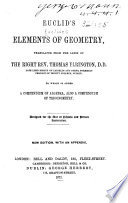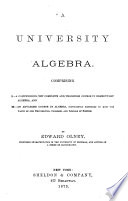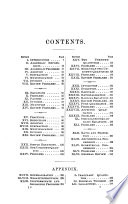 Divide the first term of the dividend by the first term of the divisor, and write the result as the first term of the quotient. Multiply the whole divisor by the first term of the quotient, and subtract the product from the dividend. Divide the first term of the dividend by the first term of the divisor, and write the result as the first term of the quotient. Multiply the whole divisor by the first term of the quotient, and subtract the product from the dividend.  Elements of Algebra - Page 26by Bourdon (M., Louis Pierre Marie) - 1831 - 304 pagesFull view Elements of Algebra - Page 26by Bourdon (M., Louis Pierre Marie) - 1831 - 304 pagesFull view - About this book
 | Euclid - Geometry - 1872 - 284 pages
...according to the power or index of a, we place them thus, a6d — ate + cPb + a2 ; and then proceed by dividing the first term of the dividend by the first term of the divisor, placing the result in the quotient. "We next multiply the whole divisor by the quotient thus found,... | |
 | Edward Olney - Algebra - 1873 - 354 pages
...polynomials. • EULE. — HAVING ARRANGED DIVIDEND AND DIVISOK WITH REFERENCE TO THE SAME LETTER, DIVIDE THE FIRST TERM OF THE DIVIDEND BY THE FIRST TERM OF THE DIVISOR FOR THE FIRST TERM OF THE QUOTIENT. TlIEN SUBTRACT FROM THE DIVIDEND THE PRODUCT OF THE DIVISOR INTO... | |
 | Daniel Barnard Hagar - Algebra - 1873 - 278 pages
...Polynomial. — Arrange the divisor and dividend according to the powers of one of their letters. Divide the first term of the dividend by the first term of the divisor, and write the result for the first term of the quotient; multiply the whole divisor by it, and subtract... | |
 | Joseph Ficklin - Algebra - 1874 - 446 pages
...according to the descending powers of a common letter as a, the first term of the quotient is found by dividing the first term of the dividend by the first term of the divisor. Hence, in this example the first term of the quo;• . - 8«4 , •> tient is nj = 4a2. Again, the... | |
 | John Charles Stone, James Franklin Millis - Algebra - 1911 - 698 pages
...the dividend and divisor according to the descending or ascending powers of some letter. 2. Divide the first term of the dividend by the first term of the divisor to obtain the first term of the quotient. 3. Multiply the whole divisor by this term of the quotient,... | |
 | Herbert Edwin Hawkes, William Arthur Luby, Frank Charles Touton - Algebra - 1911 - 288 pages
...law „a j. „s _ „e-6 The method of dividing one polynomial by another is stated in the Divide the first term of the dividend by the first term of the divisor and write the result for the first term of the quotient. Multiply the entire divisor by the first term... | |
 | William James Milne - 1911 - 360 pages
...dividend and divisor according to the ascending or the descending powers of a common letter. Divide the first term of the dividend by the first term of the divisor, and write the result for the first term of the quotientMultiply the whole divisor by this term of the... | |
 | Webster Wells, Walter Wilson Hart - Algebra - 1912 - 344 pages
...dividend and the divisor in either ascending or descending powers of some common letter. 2. Divide the first term of the dividend by the first term of the divisor, and write the result as the first term of the quotient. 3. Multiply the whole divisor by the first... | |
 | Webster Wells, Walter Wilson Hart - Algebra - 1912 - 504 pages
...dividend and the divisor in either ascending or descending powers of some common letter. 2. Divide the first term of the dividend by the first term of the divisor, and write the result as the first term of the quotient. 3. Multiply the whole divisor by the first... | |
 | Herbert Ellsworth Slaught, Nels Johann Lennes - Algebra - 1912 - 300 pages
...dividend and divisor according to descending (or ascending) powers of some common letter. 2. Divide the first term of the dividend by the first term of the divisor. This quotient is the first term of the quotient. 3. Multiply the first term of the quotient by the... | |
| |